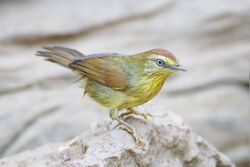Biology:Mixornis
| Mixornis | |
|---|---|

| |
| Pin-striped tit-babbler, (Mixornis gularis) | |
| Scientific classification | |
| Domain: | Eukaryota |
| Kingdom: | Animalia |
| Phylum: | Chordata |
| Class: | Aves |
| Order: | Passeriformes |
| Family: | Timaliidae |
| Genus: | Mixornis Blyth, 1842 |
| Type species | |
| Timalia chloris[1] = Motacilla rubicapilla Blyth, 1842
| |
Mixornis is a genus of passerine birds in the Old World babbler family Timaliidae.
Taxonomy
These species were formerly placed in the genus Macronus. A molecular phylogenetic study published in 2012 found that Macronus was not monophyletic. To create monophyletic genera Macronus was split and some species moved to the resurrected genus Mixornis.[2][3] Mixornis had been introduced in 1842 by the English zoologist Edward Blyth to accommodate the taxon Timalia chloris. This is a junior synonym of Macronous gularis rubicapillus which had been described in 1833 by Samuel Tickell. It is now one of the subspecies of the pin-striped tit-babbler (Mixornis gularis rubicapilla).[2][4][5] The genus name combines the Ancient Greek mixis meaning "mixed" or "mingling" with ornis meaning "bird".[6]
Species
The genus includes the following species:[2]
| Image | Common Name | Scientific name | Distribution |
|---|---|---|---|
 |
Pin-striped tit-babbler | Mixornis gularis | Bangladesh, Bhutan, Brunei, Cambodia, China, India, Indonesia, Laos, Malaysia, Myanmar, Nepal, Philippines, Singapore, Thailand and Vietnam |
| Bold-striped tit-babbler | Mixornis bornensis | Borneo, and Java | |
 |
Grey-cheeked tit-babbler | Mixornis flavicollis | Java |
| Kangean tit-babbler | Mixornis prillwitzi | the Kangean Islands | |
| Grey-faced tit-babbler | Mixornis kelleyi | Cambodia, Laos, and Vietnam |
References
- ↑ "Timalidae". The Trust for Avian Systematics. https://www.aviansystematics.org/4th-edition-checklist?viewfamilies=169.
- ↑ 2.0 2.1 2.2 Gill, Frank; Donsker, David; Rasmussen, Pamela, eds (August 2022). "Babblers & fulvettas". IOC World Bird List Version 12.2. International Ornithologists' Union. http://www.worldbirdnames.org/bow/babblers/.
- ↑ Moyle, R.G.; Andersen, M.J.; Oliveros, C.H.; Steinheimer, F.D.; Reddy, S. (2012). "Phylogeny and biogeography of the core babblers (Aves: Timaliidae)". Systematic Biology 61 (4): 631–651. doi:10.1093/sysbio/sys027.
- ↑ Blyth, Edward (1842). "Report from the curator". Journal of the Asiatic Society of Bengal 11, Part 2 (128): 788-799 [794, note]. https://www.biodiversitylibrary.org/page/40005164.
- ↑ Mayr, Ernst; Paynter, Raymond A. Jr, eds (1964). Check-List of Birds of the World. 10. Cambridge, Massachusetts: Museum of Comparative Zoology. p. 318. https://www.biodiversitylibrary.org/page/14486507.
- ↑ Jobling, James A. (2010). The Helm Dictionary of Scientific Bird Names. London: Christopher Helm. p. 257. ISBN 978-1-4081-2501-4. https://archive.org/stream/Helm_Dictionary_of_Scientific_Bird_Names_by_James_A._Jobling#page/n257/mode/1up.
- Collar, N. J. & Robson, C. 2007. Family Timaliidae (Babblers) pp. 70 – 291 in; del Hoyo, J., Elliott, A. & Christie, D.A. eds. Handbook of the Birds of the World, Vol. 12. Picathartes to Tits and Chickadees. Lynx Edicions, Barcelona.
Wikidata ☰ Q23464769 entry
 |

